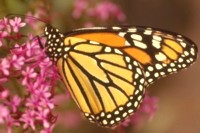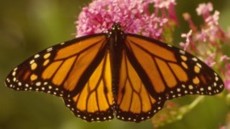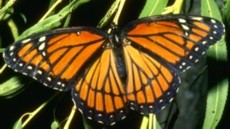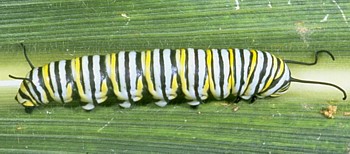|
|
ARTHROPODS:
Insects»
Spiders»
Centipedes»
Millipedes»
Sowbugs»
Harvestmen»
Mites
& Ticks»
Scorpions»
Identification
Tips»
About
the Critter Files»
Links» |
|
|
|
| |
|
Monarch Butterflies
are in the family Danaidae, and butterflies in this family are known
collectively as the "milkweed butterflies." The
Monarch, Danaus plexippus, is the only memer of this family
that occurs in Kentucky. The monarch is distinct and easy
to recognize: it has dark-orange wings with black or dark-brown
veins and dark borders with white spots. |
 Monarch Buttefly
Monarch Buttefly
(Corel Photo CD, 1993) |
| |
| The only other
Kentucky butterfly that closely resembles the monarch is the Viceroy,
Limenitis archippus, which is in the Nymphalidae family.
The Viceroy can be distinguished from the Monarch by an arc of additional
black lines that cross the hind wings of the Viceroy. |
| |
 Monarch Butterfly
Monarch Butterfly
(Corel Photo CD, 1993) |
 Viceory Butterfly:
note extra black lines on hind wings
Viceory Butterfly:
note extra black lines on hind wings
(Corel Photo CD, 1993) |
| |
| Monarch
Caterpillars are distinctive as well, with alternating black,
yellow, and white stripes. Monarch caterpillars also feature
2 black, antennae-like structures on each end of the body. |
| |
 Monarch Caterpillar
(R. Bessin, 2002)
Monarch Caterpillar
(R. Bessin, 2002) |
|
| SIZE:
Adult wingspan up to 4", caterpillar up to 2 3/4" |
| |
| LIFE
CYCLE |
|
As
with all butterflies, Monarchs have complete metamorphosis with
egg, larval, pupal, and adult stages.
Migration:
Unlike most butterflies that occur in Kentucky, the Monarch does
not live here year round. Instead, adult Monarchs spend the
winter in Mexico and the southern United States. In the spring,
adult Monarchs fly north, and some of them come to Kentucky. Here,
the females lay their eggs on milkweed plants. Caterpillars
then hatch from the eggs, feed, pupate, and emerge as butterflies.
This whole growth cycle - from egg to adult - takes only about
a month. The adult butterflies will then mate and lay eggs
multiple times until they return south in the Fall. |
| ECOLOGY |
|
| |
The caterpillars
of Monarch butterflies feed exclusively on milkweed plants and a
few other, closely related plants, such as dogbane. Most of
these plants occur in "weedy" areas, such as fence rows,
the edges of crops, fields, and similar areas. Adult Monarchs
drink nectar from flowers.
The juices in milkweed
plants are toxic to most animals, but Monarchs (and a few other
insects) have evolved an immunity to the poison. Because they
are able to store the poisons in their bodies, Monarch butterflies
and caterpillars taste bad to most predators. Most birds and
other predators will not feed on Monarch butterflies. |
| |
| PEST
STATUS |
|
Monarch
butterflies are not considered pests. |
| |
| COLLECTING
& PHOTOGRAPHY |
|
Look for adult Monarchs
throughout the summer in open fields, near the forest edge, and
around cultivated crops. They are low-flying and easy to catch,
but be sure to use a butterfly net when you capture them to keep
from damaging the wings.
Once captured, it is
best to keep any butterfly in a "butterfly envelope".
Visit this page to learn how to make your own butterfly envelopes:
http://www.kellscraft.com/butterfly01.html#COLLECTIONS
Monarchs make great photography
subjects, but getting a good picture can be a challenge - even when
Monarchs aren't flying, they are almost always walking around or
moving their wings up and down. It may be necessary to take
many pictures. Another trick that works with most insects:
find a Monarch early on a cool summer morning. It will still
be warming itself and will be less likely to fly away.
Monarch caterpillars
are much slower moving than the adults, and are found almost anywhere
milkweed grows. Remember that all insect larvae should be
preserved in alcohol.
You can also raise a
monarch from caterpillar to adult. All you have to do is find
a monrach caterpillar in tne summer and feed it milkweed until it
pupates. This will take only a few weeks. Make sure
to learn how to identify milkweed plants so that you can give the
caterpillar the right kind of food. |
| |
| MONARCH
FACTS |
|
It is not an accident
that Viceroy butterflies look like Monarch butterflies. Scientists
believe that Viceroys have evolved to look the way they do to take
advantage of a Monarch's defense. Since Monarchs eat milkweed,
they are bad-tasting to birds. Viceroys do not feed on milkweed,
and are not bad-tatsing. But if a bird tries to eat a Monarch
and finds that it tastes bad, it will "remember" the way
a Monarch looks - it may then avoid eating Viceroy butterflies too.
Read more about insect mimecry at the Natureworks page on
Viceroy Butterflies:
http://www.nhptv.org/natureworks/viceroy.htm
The Monarch butterfly
is in danger of loosing its habitat. Read more about threats
to the Monarch butterfly in the "monarch links" below. |
| |
| MONARCH
LINKS |
|
The Monarch butterfly
may be the most well-known and beloved insect species in the
United States. Because of this, and because it is in danger
of habitat loss, and there are many webpages devoted to these butterflies.
Here are some of the best:
The Monarch Watch Program
from the University of Kansas:
http://www.monarchwatch.org/
The Science Museum of
Minnesota's Monarchs & Migration page:
http://www.smm.org/sln/monarchs/
The Texas Monarch Project:
http://www.rice.edu/armadillo/Ftbend/newfly.html
|
| |
| MYTHS
- LEGENDS - FOLKLORE |
|
Do you know any myths,
legends, or folklore about Monarchs? Let us know if you do!
|
| |
Original document: 25 May 2004
Last updated: 25 May 2004
Monarch and Viceroy
Butterfly photos courtesy Corel, 1993. Used with permission. Other
pPhotos courtesy R. Bessin and B. Newton, University of Kentucky
The Kentucky Critter Files are maintained by Blake Newton, Department
of Entomology, University of Kentucky.
Contact: blaken@uky.edu |
|

